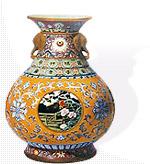
Jingdezhen, China's capital of porcelain-making industry, used to be known as Changnan and Xinping. During the Jingde reign (1004-1007) of the Song, the quality porcelains made by local artisans drew the attention of Emperor Zhenzong, who designated them for imperial use and had the wording "Made during the Jingde Reign" printed on the bottom of every piece of porcelain made there. Hence the name, Jingdezhen. A 1,700-year-old history in the making of porcelain has pockmarked the land of he city with ancient kilns, and nurtured a distinctive folklore. A visit to the place never fails to become a most rewarding experience. Panlong Town in the west of the city is the site of the Jingdezhen Porcelain Museum, whose cluster of Ming and Qing buildings and Ming porcelain-making kilns capture exactly the essence of the local cultural heritage.Longzhu Pavilion, built on the top of Zhu Hill, was the symbol of Jingdezhen from centuries ago. There re numerous curiosities of china-ware and historic data about official kiln. Today, Longzhu Pavilion is not only a treasure for the research on history, but also a hot spot for tourists.Around the Jingdezhen Ceramics Museum, there re many groups of ancient buildings. They provide us with rich but rare materials for research on the economy, architecture and porcelain-making history. Meanwhile, the area is also a scenic spot due to its high aesthetic values and traveling values.





